
William Michael Dranginis 1/18/1959 – 12/3/2018
Bill Dranginis searched for Bigfoot and Champ. He found friends and students.
On December 3, 2018, William “Bill” Dranginis, who had been fighting pancreatic cancer, passed away. He had moved to Florida, to be near family, in the last few months.
Bill Dranginis, age 59, was a surveillance and security expert, originally from Manassas, Virginia. In 1995, Bill had a sighting of a Bigfoot while metal detecting with friends in the forests near Culpeper, Virginia, and had since then dedicated his free time and efforts to capturing video and or audio evidence as proof of the creatures existence.
In 2001, Bill purchased a 24 foot mobile veterinary unit and converted it into the worlds only Bigfoot Research Lab. Bill spent over $50,000 to outfit the vehicle with state-of-the-art gear, most of it custom built. He mounted a Raytheon NightSight 200 thermal camera on a 25-foot-tall crank up mast that could detect an animal in the dark 800 yards away. The vehicle also had two night-vision scopes, a surface-to-aircraft radio, and TV monitors that can combine images from roof-mounted video cams into one 360-degree view, or receive feeds from remote cams in the woods. Bill sold the Bigfoot Research vehicle to purchase a more permanent Bigfoot research station in the hills of West Virginia. Bill is a highly respected researcher in the field and he created the “EyeGotcha” Digital Video surveillance system. This system is virtually sound proof and can be deployed in the forests for long periods of time. The camera captures full motion video and audio that can be uploaded to a computer for later analysis. Bill felt it would be the break-through the Bigfoot field had waited for as far as the ability to capture video and audio of Bigfoot. He also created a company to manufacture and sell the EyeGotcha camera systems. Bill was a FLIR Certified Level 1 Thermographer and has extensive knowledge with camouflage, concealment and deception techniques.
Champ


In recent years, Bill used technology to electronically capture Champ, the Lake Champlain creatures in a similar fashion, going on various Champ expeditions, buy boats and outfitting them with his equipment.




Setting underwater cameras and hydrophones — with William Dranginis, Tea Krulos and Jeff Meuse at Lake Champlain VT.






Bill at Champ Camp, 2013.
Bigfoot

In July of 2008, the following appeared in the media:
Thirteen years ago, William Dranginis saw Bigfoot. Fifty grand, a van, and a camera in a log later, the quest continues.
William Dranginis knows what you’re thinking, so maybe it’s best to get a few things straight right from the start. He’s not crazy, delusional, some lunatic on the fringe. For the most part, he’s your average suburban family man. Lives on a quiet street in Manassas. Has a great wife and two daughters; just became a grandfather. Has a good job designing surveillance equipment for the Windermere Group, an Annapolis-based technology firm that does contract work for the government.
He can’t help that he saw Bigfoot in the woods near Culpeper, Va., on March 11, 1995. Two witnesses were with him, both FBI agents. It’s not like he imagined the incident. In the 13 years since, he has spent more than $50,000 trying to prove Bigfoot exists. He has created sophisticated surveillance systems—wait till you hear about his new Eye Gotcha system!—and even designed a tricked-out research van with parabolic microphones and thermal and night-vision cameras….
So began an article about cryptozoology’s friend, Bill Dranginis, in that issue ten years ago of Washington City Paper.
The story contained a good array of photographs, nicely highlighting the work Dranginis is undertaking. They were worthy visuals for the profile.
In conjunction with the article, City Paper has also posted a video (which, unfortunately, appears to have been taken offline), which had Bill telling of his firsthand encounter, showing him investigating a new case, and looking at his interview. The video made a nice companion to the article and photos.
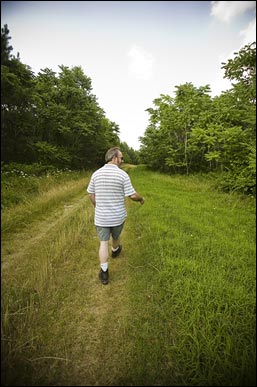
In the profile, Dranginis walked where Bigfoot might have at the “Southern Virginia Research Location.” (Photograph by Darrow Montgomery)
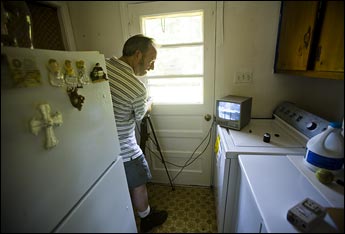
Dranginis monitored his motion-detection camera. (Photograph by Darrow Montgomery)
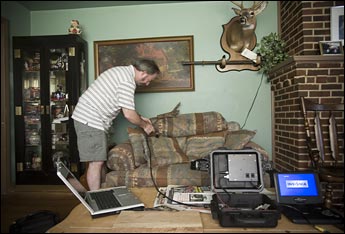
Dranginis demonstrated his Eye Gotcha invention. (Photograph by Darrow Montgomery)
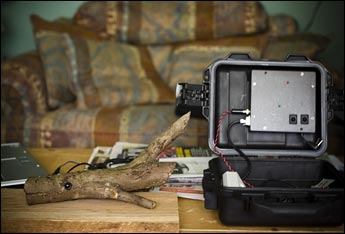
The Eye Gotcha system included a camera in a log decoy. (Photograph by Darrow Montgomery)
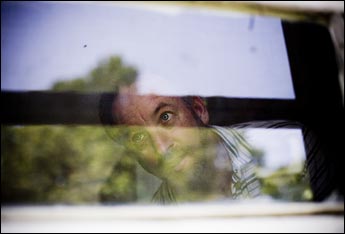
Dranginis checked the angle of his surveillance camera. (Photograph by Darrow Montgomery)
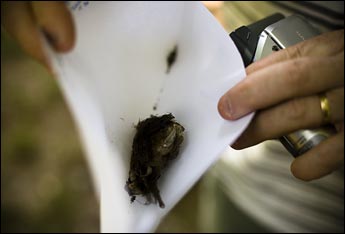
Is it Bigfoot hair or plant material? (Photograph by Darrow Montgomery)
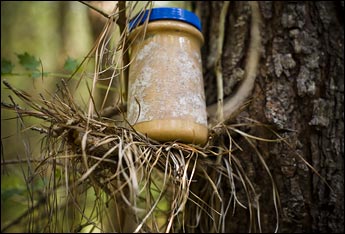
Dranginis’ Bigfoot bait/peanut butter had been sitting there for four years. (Photograph by Darrow Montgomery)
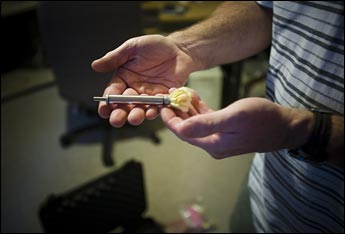
A DNA dart for Dranginis’ dart gun. (Photograph by Darrow Montgomery)

Every spring, Dranginis bought another case of Bigfoot Ale, hoping he’ll find the creature and the beer would become a collector’s item. (Photograph by Darrow Montgomery)
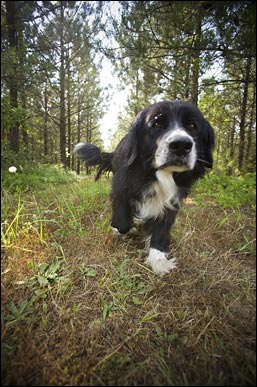
Bill’s faithful dog (Photograph by Darrow Montgomery)
The cover story by Eric Wills was entitled “Hot for Creature.”
From the article:
After 13 years of research and more than $50,000, Dranginis has some grainy video footage and photos, tracks he’s discovered, eyewitness accounts—and still no hard evidence. He’s posted this motto on a sheet of paper in his basement: absence of evidence is not evidence of absence.
Lest we forget, one of Bigfooter William Dranginis’ priority goals was sharing the experience of his passion of the pursuit in the classroom.
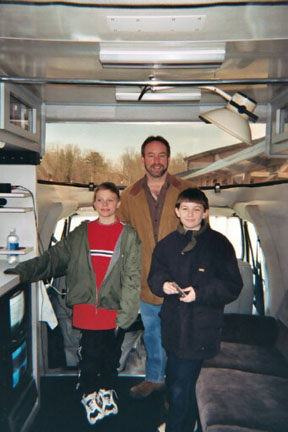
Bigfooter William Dranginis of Manassas, Virginia, shared the following experience about his time using Bigfoot in the classroom:
I was contacted by a local Science teacher a couple years ago and asked to come to her class and speak to them about the Bigfoot creatures and how one goes about researching a creature that the scientific community says does not exist. We discussed scientific methodology and how some Bigfoot researchers use this methodology in our research. We also discussed equipment researcher’s use in their quest, I even brought down the Bigfoot Research vehicle and allowed them to operate the thermal cameras and other gear, they really enjoyed that!
I came away knowing that there will be a new scientifically minded generation of Cryptozoologists coming up in the ranks. The questions they asked were amazing, I have no doubt, the future is in good hands.

The photographs are ones Dranginis sent along from that trip.
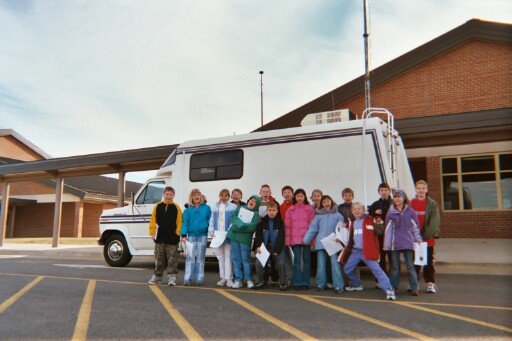
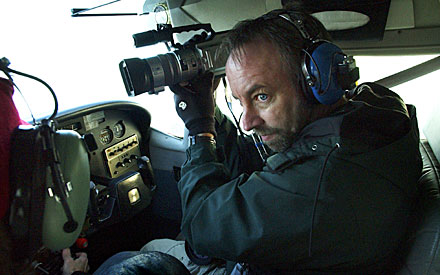
Dranginis’ high tech van was very popular as a teaching tool.
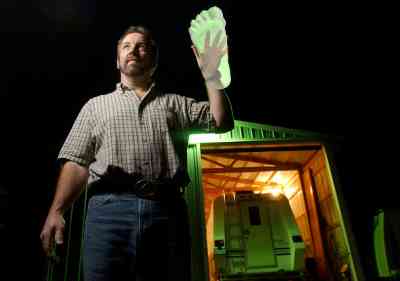
Bill was going to come to the International Cryptozoology Conference in 2018, and we missed him deeply when he had to cancel due to his cancer. I talked with him often in the last months, and this is a sad time for many of us.

Personally, I would like to thank Bill Dranginis, once again, for his donation of unbreakable, kid-friendly, nearly transparent two-part clear urethane display casts of the footprints of various hominoids, to the International Cryptozoology Museum. It has been great working with Bill on his educational projects. Dranginis’s specially designed casts are a great resource invention. His sharing will live on, and the experiences he had with me, Jeff Meuse, Craig Woolheater, Tea Krulos, Diana Esordi, Michael Esordi, Scott Mardis, Dave McCullough, and so many others will never be forgotten.

Goodbye, Bill. You will be missed.

[...] William Dranginis Dies [...]